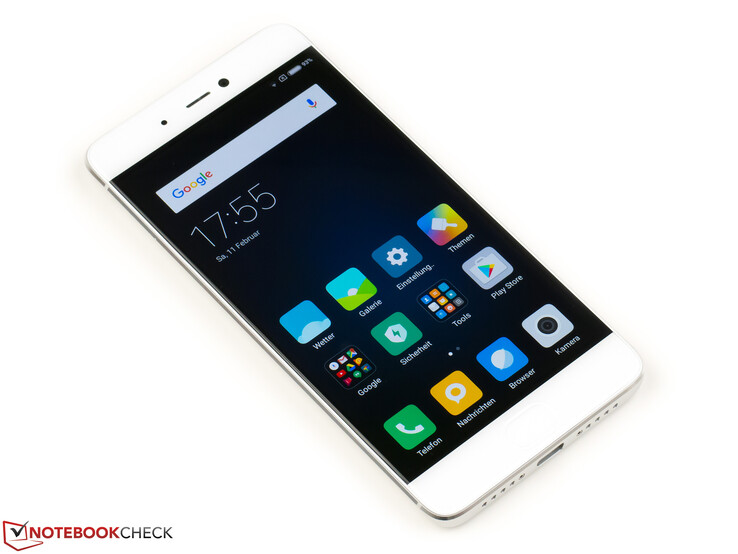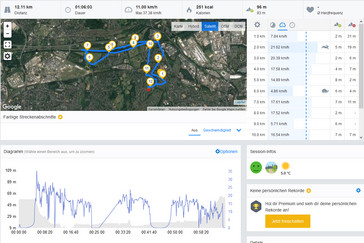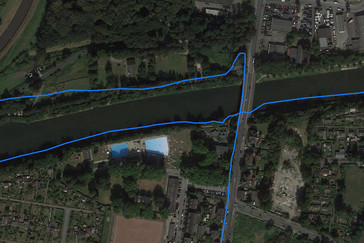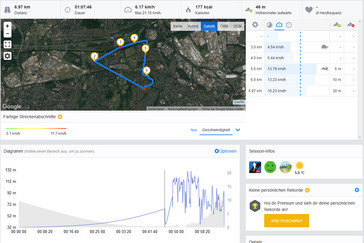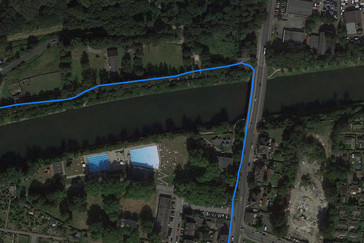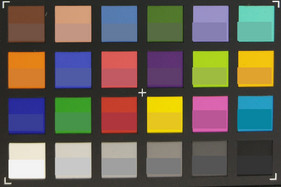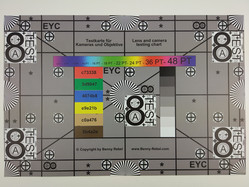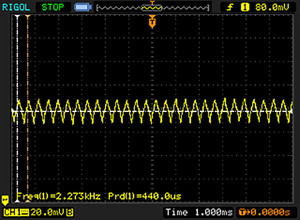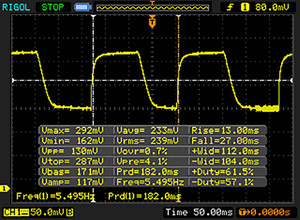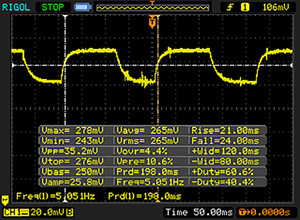小米 Mi 5s 智能手机简短评测
» Notebookcheck多媒体笔记本电脑Top 10排名
» Notebookcheck游戏笔记本电脑Top 10排名
» Notebookcheck低价办公/商务笔记本电脑Top 10排名
» Notebookcheck高端办公/商务笔记本电脑Top 10排名
» Notebookcheck工作站笔记本电脑Top 10排名
» Notebookcheck亚笔记本电脑Top 10排名
» Notebookcheck超级本产品Top 10排名
» Notebookcheck变形本产品Top 10排名
» Notebookcheck平板电脑Top 10排名
» Notebookcheck智能手机Top 10排名
» Notebookcheck评测过最出色的笔记本电脑屏幕
» Notebookcheck售价500欧元以下笔记本电脑Top 10排名
» Notebookcheck售价300欧元以下笔记本电脑Top 10排名
| Networking | |
| iperf3 transmit AX12 | |
| Apple iPhone 7 (Klaus I211) | |
| Samsung Galaxy S7 | |
| OnePlus 3T | |
| Xiaomi Mi 5s | |
| Huawei P9 | |
| Lenovo Moto Z Play | |
| iperf3 receive AX12 | |
| Apple iPhone 7 (Klaus I211) | |
| Xiaomi Mi 5s | |
| Samsung Galaxy S7 | |
| Huawei P9 | |
| OnePlus 3T | |
| Lenovo Moto Z Play | |
| |||||||||||||||||||||||||
Brightness Distribution: 91 %
Center on Battery: 593 cd/m²
Contrast: 1045:1 (Black: 0.6 cd/m²)
ΔE ColorChecker Calman: 4.5 | ∀{0.5-29.43 Ø4.78}
ΔE Greyscale Calman: 4.5 | ∀{0.09-98 Ø5}
Gamma: 2.26
CCT: 7427 K
| Xiaomi Mi 5s IPS, 1920x1080, 5.2" | Samsung Galaxy S7 SAMOLED, 2560x1440, 5.1" | OnePlus 3T Optic-AMOLED, 1920x1080, 5.5" | Huawei P9 IPS-NEO, JDI, 1920x1080, 5.2" | HTC 10 Super LCD 5, 2560x1440, 5.2" | Xiaomi Mi 5 IPS, 1920x1080, 5.2" | |
|---|---|---|---|---|---|---|
| Screen | ||||||
| Brightness middle (cd/m²) | 627 | 350 -44% | 421 -33% | 582 -7% | 445 -29% | 598 -5% |
| Brightness (cd/m²) | 596 | 351 -41% | 430 -28% | 563 -6% | 434 -27% | 566 -5% |
| Brightness Distribution (%) | 91 | 98 8% | 84 -8% | 91 0% | 93 2% | 90 -1% |
| Black Level * (cd/m²) | 0.6 | 0.38 37% | 0.36 40% | 0.51 15% | ||
| Contrast (:1) | 1045 | 1532 47% | 1236 18% | 1173 12% | ||
| Colorchecker dE 2000 * | 4.5 | 2.04 55% | 7.1 -58% | 4.4 2% | 2.8 38% | 3.5 22% |
| Colorchecker dE 2000 max. * | 7.5 | 3.25 57% | 15.3 -104% | 7.4 1% | 5.8 23% | 6.1 19% |
| Greyscale dE 2000 * | 4.5 | 1.63 64% | 6.8 -51% | 4.8 -7% | 3.7 18% | 3.5 22% |
| Gamma | 2.26 97% | 2.07 106% | 2.23 99% | 2.2 100% | 2.31 95% | 2.29 96% |
| CCT | 7427 88% | 6391 102% | 7866 83% | 6175 105% | 7164 91% | 6532 100% |
| Color Space (Percent of AdobeRGB 1998) (%) | 86.86 | 77.78 | ||||
| Color Space (Percent of sRGB) (%) | 99.35 | 99.44 |
* ... smaller is better
Screen Flickering / PWM (Pulse-Width Modulation)
| Screen flickering / PWM detected | 2273 Hz | ≤ 17 % brightness setting | |
The display backlight flickers at 2273 Hz (worst case, e.g., utilizing PWM) Flickering detected at a brightness setting of 17 % and below. There should be no flickering or PWM above this brightness setting. The frequency of 2273 Hz is quite high, so most users sensitive to PWM should not notice any flickering. In comparison: 53 % of all tested devices do not use PWM to dim the display. If PWM was detected, an average of 8111 (minimum: 5 - maximum: 343500) Hz was measured. | |||
Display Response Times
| ↔ Response Time Black to White | ||
|---|---|---|
| 40 ms ... rise ↗ and fall ↘ combined | ↗ 13 ms rise | |
| ↘ 27 ms fall | ||
| The screen shows slow response rates in our tests and will be unsatisfactory for gamers. In comparison, all tested devices range from 0.1 (minimum) to 240 (maximum) ms. » 97 % of all devices are better. This means that the measured response time is worse than the average of all tested devices (20.2 ms). | ||
| ↔ Response Time 50% Grey to 80% Grey | ||
| 45 ms ... rise ↗ and fall ↘ combined | ↗ 21 ms rise | |
| ↘ 24 ms fall | ||
| The screen shows slow response rates in our tests and will be unsatisfactory for gamers. In comparison, all tested devices range from 0.165 (minimum) to 636 (maximum) ms. » 76 % of all devices are better. This means that the measured response time is worse than the average of all tested devices (31.6 ms). | ||
| AnTuTu v6 - Total Score (sort by value) | |
| Xiaomi Mi 5s | |
| Samsung Galaxy S7 | |
| OnePlus 3T | |
| Huawei P9 | |
| HTC 10 | |
| Xiaomi Mi 5 | |
| Geekbench 4.0 | |
| 64 Bit Multi-Core Score (sort by value) | |
| Xiaomi Mi 5s | |
| OnePlus 3T | |
| Huawei P9 | |
| 64 Bit Single-Core Score (sort by value) | |
| Xiaomi Mi 5s | |
| OnePlus 3T | |
| Huawei P9 | |
| Compute RenderScript Score (sort by value) | |
| Xiaomi Mi 5s | |
| Huawei P9 | |
| PCMark for Android - Work performance score (sort by value) | |
| Xiaomi Mi 5s | |
| Samsung Galaxy S7 | |
| OnePlus 3T | |
| Huawei P9 | |
| HTC 10 | |
| Xiaomi Mi 5 | |
| Octane V2 - Total Score (sort by value) | |
| Xiaomi Mi 5s | |
| Samsung Galaxy S7 | |
| OnePlus 3T | |
| Huawei P9 | |
| HTC 10 | |
| Xiaomi Mi 5 | |
| Mozilla Kraken 1.1 - Total (sort by value) | |
| Xiaomi Mi 5s | |
| Samsung Galaxy S7 | |
| OnePlus 3T | |
| Huawei P9 | |
| HTC 10 | |
| Xiaomi Mi 5 | |
| JetStream 1.1 - Total Score (sort by value) | |
| Xiaomi Mi 5s | |
| Samsung Galaxy S7 | |
| OnePlus 3T | |
| Huawei P9 | |
| HTC 10 | |
| Xiaomi Mi 5 | |
| GFXBench (DX / GLBenchmark) 2.7 | |
| T-Rex Onscreen (sort by value) | |
| Xiaomi Mi 5s | |
| Samsung Galaxy S7 | |
| OnePlus 3T | |
| Huawei P9 | |
| HTC 10 | |
| Xiaomi Mi 5 | |
| 1920x1080 T-Rex Offscreen (sort by value) | |
| Xiaomi Mi 5s | |
| Samsung Galaxy S7 | |
| OnePlus 3T | |
| Huawei P9 | |
| HTC 10 | |
| Xiaomi Mi 5 | |
| GFXBench 3.0 | |
| 1920x1080 1080p Manhattan Offscreen (sort by value) | |
| Xiaomi Mi 5s | |
| Samsung Galaxy S7 | |
| OnePlus 3T | |
| Huawei P9 | |
| HTC 10 | |
| Xiaomi Mi 5 | |
| on screen Manhattan Onscreen OGL (sort by value) | |
| Xiaomi Mi 5s | |
| Samsung Galaxy S7 | |
| OnePlus 3T | |
| Huawei P9 | |
| HTC 10 | |
| Xiaomi Mi 5 | |
| GFXBench 3.1 | |
| 1920x1080 Manhattan ES 3.1 Offscreen (sort by value) | |
| Xiaomi Mi 5s | |
| Samsung Galaxy S7 | |
| OnePlus 3T | |
| Huawei P9 | |
| HTC 10 | |
| Xiaomi Mi 5 | |
| on screen Manhattan ES 3.1 Onscreen (sort by value) | |
| Xiaomi Mi 5s | |
| Samsung Galaxy S7 | |
| OnePlus 3T | |
| Huawei P9 | |
| HTC 10 | |
| Xiaomi Mi 5 | |
| 3DMark | |
| 1280x720 offscreen Ice Storm Unlimited Physics (sort by value) | |
| Xiaomi Mi 5s | |
| Samsung Galaxy S7 | |
| OnePlus 3T | |
| Huawei P9 | |
| HTC 10 | |
| Xiaomi Mi 5 | |
| 1280x720 offscreen Ice Storm Unlimited Graphics Score (sort by value) | |
| Xiaomi Mi 5s | |
| Samsung Galaxy S7 | |
| OnePlus 3T | |
| Huawei P9 | |
| HTC 10 | |
| Xiaomi Mi 5 | |
| 1280x720 offscreen Ice Storm Unlimited Score (sort by value) | |
| Xiaomi Mi 5s | |
| Samsung Galaxy S7 | |
| OnePlus 3T | |
| Huawei P9 | |
| HTC 10 | |
| Xiaomi Mi 5 | |
| 2560x1440 Sling Shot OpenGL ES 3.0 Physics (sort by value) | |
| Xiaomi Mi 5s | |
| Samsung Galaxy S7 | |
| OnePlus 3T | |
| Huawei P9 | |
| HTC 10 | |
| Xiaomi Mi 5 | |
| 2560x1440 Sling Shot OpenGL ES 3.0 Graphics (sort by value) | |
| Xiaomi Mi 5s | |
| Samsung Galaxy S7 | |
| OnePlus 3T | |
| Huawei P9 | |
| HTC 10 | |
| Xiaomi Mi 5 | |
| 2560x1440 Sling Shot OpenGL ES 3.0 (sort by value) | |
| Xiaomi Mi 5s | |
| Samsung Galaxy S7 | |
| OnePlus 3T | |
| Huawei P9 | |
| HTC 10 | |
| Xiaomi Mi 5 | |
| AndroBench 3-5 | |
| Random Write 4KB (sort by value) | |
| Xiaomi Mi 5s | |
| Samsung Galaxy S7 | |
| OnePlus 3T | |
| Huawei P9 | |
| HTC 10 | |
| Xiaomi Mi 5 | |
| Random Read 4KB (sort by value) | |
| Xiaomi Mi 5s | |
| Samsung Galaxy S7 | |
| OnePlus 3T | |
| Huawei P9 | |
| HTC 10 | |
| Xiaomi Mi 5 | |
| Sequential Write 256KB (sort by value) | |
| Xiaomi Mi 5s | |
| Samsung Galaxy S7 | |
| OnePlus 3T | |
| Huawei P9 | |
| HTC 10 | |
| Xiaomi Mi 5 | |
| Sequential Read 256KB (sort by value) | |
| Xiaomi Mi 5s | |
| Samsung Galaxy S7 | |
| OnePlus 3T | |
| Huawei P9 | |
| HTC 10 | |
| Xiaomi Mi 5 | |
* ... smaller is better
(±) The maximum temperature on the upper side is 40.5 °C / 105 F, compared to the average of 35.2 °C / 95 F, ranging from 21.9 to 247 °C for the class Smartphone.
(+) The bottom heats up to a maximum of 36.4 °C / 98 F, compared to the average of 34 °C / 93 F
(+) In idle usage, the average temperature for the upper side is 30.5 °C / 87 F, compared to the device average of 32.9 °C / 91 F.
Xiaomi Mi 5s audio analysis
(+) | speakers can play relatively loud (85 dB)
Bass 100 - 315 Hz
(-) | nearly no bass - on average 18.6% lower than median
(±) | linearity of bass is average (7.8% delta to prev. frequency)
Mids 400 - 2000 Hz
(±) | higher mids - on average 7.8% higher than median
(+) | mids are linear (6.3% delta to prev. frequency)
Highs 2 - 16 kHz
(±) | higher highs - on average 6.1% higher than median
(±) | linearity of highs is average (7.9% delta to prev. frequency)
Overall 100 - 16.000 Hz
(±) | linearity of overall sound is average (24.5% difference to median)
Compared to same class
» 58% of all tested devices in this class were better, 7% similar, 35% worse
» The best had a delta of 11%, average was 35%, worst was 134%
Compared to all devices tested
» 73% of all tested devices were better, 6% similar, 21% worse
» The best had a delta of 4%, average was 24%, worst was 134%
Xiaomi Mi 5 audio analysis
(+) | speakers can play relatively loud (86.5 dB)
Bass 100 - 315 Hz
(-) | nearly no bass - on average 23.1% lower than median
(±) | linearity of bass is average (11.8% delta to prev. frequency)
Mids 400 - 2000 Hz
(+) | balanced mids - only 3.7% away from median
(+) | mids are linear (5.1% delta to prev. frequency)
Highs 2 - 16 kHz
(±) | higher highs - on average 8.9% higher than median
(+) | highs are linear (4.1% delta to prev. frequency)
Overall 100 - 16.000 Hz
(±) | linearity of overall sound is average (22.7% difference to median)
Compared to same class
» 49% of all tested devices in this class were better, 6% similar, 45% worse
» The best had a delta of 11%, average was 35%, worst was 134%
Compared to all devices tested
» 66% of all tested devices were better, 6% similar, 28% worse
» The best had a delta of 4%, average was 24%, worst was 134%
| Off / Standby | |
| Idle | |
| Load |
|
Key:
min: | |
| Xiaomi Mi 5s 3200 mAh | Samsung Galaxy S7 3000 mAh | OnePlus 3T 3400 mAh | Huawei P9 3000 mAh | HTC 10 3000 mAh | Xiaomi Mi 5 3000 mAh | |
|---|---|---|---|---|---|---|
| Power Consumption | 9% | -18% | -15% | -19% | -4% | |
| Idle Minimum * (Watt) | 0.4 | 0.68 -70% | 0.61 -53% | 0.77 -93% | 0.68 -70% | 0.45 -13% |
| Idle Average * (Watt) | 1.7 | 1.02 40% | 1.77 -4% | 2.36 -39% | 1.49 12% | 1.68 1% |
| Idle Maximum * (Watt) | 1.81 | 1.14 37% | 1.81 -0% | 2.37 -31% | 1.91 -6% | 1.71 6% |
| Load Average * (Watt) | 5.84 | 4.73 19% | 6.67 -14% | 3.09 47% | 7.4 -27% | 6.7 -15% |
| Load Maximum * (Watt) | 9.12 | 7.16 21% | 10.98 -20% | 5.35 41% | 9.71 -6% | 9.18 -1% |
* ... smaller is better
| Xiaomi Mi 5s 3200 mAh | Samsung Galaxy S7 3000 mAh | OnePlus 3T 3400 mAh | Huawei P9 3000 mAh | HTC 10 3000 mAh | Xiaomi Mi 5 3000 mAh | |
|---|---|---|---|---|---|---|
| Battery runtime | ||||||
| WiFi v1.3 (h) | 11.1 | 7.6 -32% | 8.2 -26% | 9.5 -14% | 6.9 -38% | 8.4 -24% |
Pros
Cons
小米Mi 5s在许多方面令人印象深刻。在功能方面没有太多妥协:Mi 5s支持双SIM卡,屏幕非常明亮,用户界面MIUI 8. 0提供了大量的附加功能。除了良好的性能,该机在我们实际局域网测试中的续航时间也长。它主要的缺点是:小米忽略了去适应欧洲市场。Global ROM可以弥补一些缺点,但这仍然是一个遗憾——Mi 5s不支持常用的LTE 频带20。一些感兴趣的用户也可能不敢购买,因为该智能手机需要进口。
小米的Mi 5s将高短配件转配在高档金属外壳中。价格加算上运费和税收,是300欧元(约317美元)起,价位属于中上水平。从国外买,可以说是一个有吸引力的方案。
在欧洲,该机和其他(官方进口)顶级智能机之间的存在价差,在某些情况下,更为便宜。当然,我们所比较的其他手机,也有起步价格450欧元(〜475美元)的。
注:本文是基于完整评测的缩减版本,阅读完整的英文评测,请点击这里。
Xiaomi Mi 5s
- 02/24/2017 v6 (old)
Andreas Kilian




